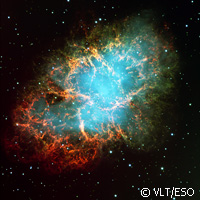Physicists hunt for clues to element formation on islands of inversion
An international team of scientists has shed new light on how heavier elements are formed during supernovae. The team, which was partly funded by the EU, arrived at its conclusions after exploring so-called islands of inversion, where atomic nuclei take on unexpected shapes. The study was published in the journal Physical Review Letters. EU support for the work came from the EURONS ('European nuclear structure integrated infrastructure initiative') project, which received EUR 14 million under the 'Research infrastructures' budget line of the Sixth Framework Programme (FP6). When the universe was born, it contained only the very lightest elements - hydrogen and helium. Other relatively light elements such as carbon and oxygen were created inside the first stars through the fusion of atomic nuclei. However, elements heavier than iron (including gold, silver and uranium) owe their existence to supernovae. When stars explode, a wide range of heavy atomic nuclei are generated. These typically decay to more stable elements via a series of short-lived intermediate stages. Atomic nuclei consist of different numbers of protons and neutrons, and atomic physicists have come up with a model to predict which combinations of neutrons and protons should be the most stable. Of particular interest to physicists are so-called 'magic numbers'; if a nucleus' collection of protons and neutrons matches a 'magic number', it will have a stable structure and be almost perfectly spherical in shape. However, sometimes nuclei that should be 'magical' do not conform to physicists' expectations; these form so-called 'islands of inversion'. One example here is the supposedly magic nucleus of isotope of magnesium-32, which comprises 12 protons and 20 neutrons. According to the theory, magnesium-32's nucleus should be perfectly spherical. In fact, in its lowest energy state, the nucleus is shaped more like a rugby ball or American football than a sphere. To study this island of inversion, the researchers created magnesium-32 by firing magnesium-30 at a radioactive isotope (version) of hydrogen called tritium. In this process, two neutrons were transferred from the tritium nuclei to the magnesium nuclei, creating magnesium-32. The experiments took place at CERN, the European Organization for Nuclear Research in Switzerland. According to the theory, magnesium 32-should only switch from its deformed shape to a spherical form when it reaches higher states of energy. This study represents the first time that researchers have confirmed the existence of a spherical version of the magnesium-32 nucleus. In fact, the researchers found that magnesium-32 takes on a spherical shape at a much lower level than had been predicted. The researchers note that this raises questions about the accuracy of models predicting changes in atomic structure. Further experiments will be needed before researchers can provide a full description of processes taking place in islands of inversion. 'We were overjoyed to have finally succeeded in confirming the existence of the spherical magnesium-32 nucleus,' commented Professor Reiner Krücken, Chair of Hadrons and Nuclear Physics at the Technische Universität München in Germany. 'But these insights present new challenges to us physicists. In order to be able to predict the exact course of element synthesis in stellar explosions, we need to better understand the mechanism that causes the changes in shell structure.' Also participating in the study were scientists in Belgium, Denmark, France, Germany, Spain, the UK and the US.For more information, please visit: Technische Universität München:http://www.tumuenchen.de/ Physical Review Letters:http://prl.aps.org/
Countries
Belgium, Switzerland, Germany, Denmark, Spain, France, Italy, United Kingdom, United States



